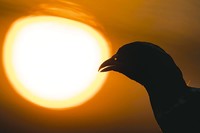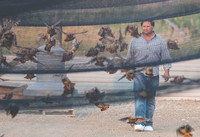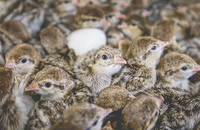Partly Cloudy, 35° F
“It just kind of snowballed,” Karl Bear, manager of the game bird rearing facility, said.
This year, the state’s largest game bird operation plans to raise 40,000 pheasant and chukar. When the company was first getting off the ground with …
This item is available in full to subscribers.
The Powell Tribune has expanded its online content. To continue reading, you will need to either log in to your subscriber account, or purchase a subscription.
If you are a current print subscriber, you can set up a free web account by clicking here.
If you already have a web account, but need to reset it, you can do so by clicking here.
If you would like to purchase a subscription click here.
Please log in to continue |
|




It all started as a family project 22 years ago. But then the tiny enterprise grew larger than they dared dream. Now a rural Powell business, Diamond Wings Upland Game Birds, LLC, has a seat at the table in a national debate about sage grouse and has a chance to make history.
“It just kind of snowballed,” Karl Bear, manager of the game bird rearing facility, said.
This year, the state’s largest game bird operation plans to raise 40,000 pheasant and chukar. When the company was first getting off the ground with 700 birds, Bear was the director of admissions for Northwest College. Now, after the business was purchased by former state Senator Diemer True in 2016, Bear continues to operate the sophisticated incubation, hatchery and rearing complex with more than 10 acres of flight pens under net — and they hope to be the first in the U.S. to rear greater sage grouse for release in the wild.
When the Wyoming Legislature passed House Bill 271, a law that allows private game farms to raise the Cowboy State’s iconic sage grouse, Diamond Wings became the leading candidate to be certified to take part in what has been called a great experiment.
There was a time that school children in Powell were welcome to tour the game bird farm. But those tours have ended in an effort to protect the birds. The tours were a student favorite, but as children traveled through the dozens of pens, incubation and rearing facilities, they carried the possibility of disease on the bottoms of their shoes.
Biosecurity concerns were tight before there was a chance to raise the imperiled species. Now, Diamond Wings is planning a brand new complex specifically to join the controversial efforts to breed the famous bird of the sagebrush sea. But first, they must get certified.
The Wyoming Game and Fish Commission on Wednesday voted unanimously to pass regulations detailing the certification process that would allow up to five private game bird farms to collect wild sage grouse eggs and raise the birds in an attempt to successfully breed the species for release in the wild.
Some measure success by whether the captively bred sage grouse can breed in the wild. Secretary of the Interior Ryan Zinke seems to be counting on captive breeding efforts to be successful.
His Secretarial Order 3353 started a 60-day review that resulted in tinkering with a multi-state Obama-era collaboration that had convinced the U.S. Fish and Wildlife Service to keep the species from being listed for protection by the Endangered Species Act. Zinke’s order hopes to use population targets rather than habitat conservation.
Yet during the commission meeting in Casper, Diemer True attempted to set the record straight.
“I don’t think it’s reasonable to think that raising a captive population would be a material augmentation to wild populations. What we’re trying to do is have one additional arrow in the quiver that would help avoid having the listing of the bird as endangered,” True said. “This is supplemental to efforts on habitat.”
As there has been since the Wyoming Legislature took up HB 271, there were many protests heard at the commission meeting — most concerned that any change from a habitat-based conservation plan to population targets would be harmful to sage grouse and the hundreds of species that live in sagebrush ecosystems.
The same voices were heard loud and clear when Zinke initiated the 60-day review of the Obama-era plan, which was based on 10 years of research and negotiations among states. The recommendations resulting from the review confirmed concerns and criticism were quickly voiced, including from Wyoming Gov. Matt Mead.
“I am concerned that the recommendations place more focus on population targets and captive breeding. Industry needs predictability, but the report does not explain fully how population targets provide that certainty. Wyoming will continue to rely on science and scientists to manage the species,” Mead said in a statement released after the review committee recommendations were identified.
More recommendations from the review committee are expected later this year and again in 2018.
True, a former commission member and owner of Diamond Wings, has met with individuals on the review team. While he’s hopeful that his game bird farm can become certified to attempt to raise sage grouse, he knows it is an uphill battle.
“I’m keenly aware I may be drilling a dry hole. It’s experimental,” he said. “But it’s worth attempting.”
True expects that, if his company becomes certified, it will be two years before they can even begin collecting eggs in the wild — an extremely complicated process — to be incubated and reared in their yet-to-be built facility.
A new facility is necessary due to a stipulation in the regulations that the sage grouse facilities be at least 100 feet from any other game bird rearing stations. The commission, along with several conservation groups expressing concern, is worried about the possibility of the spread of disease.
The Powell game bird farm has the land on which to build, but it will be expensive and all funds will come out of their own pockets.
According to the new regulations, collection of eggs can only take place for 20 days in late April and early May; only 40 nests can be disturbed per certification and only 250 eggs per season may be collected. Pointing dogs have been approved for the process, but Bear hopes to get approval to use radio transmitters to find full clutches. Dogs can find the birds, but using radio telemetry can pinpoint full clutches, he said.
Bear has been preparing for the possibility of doing the experiment. He’s traveled to the Calgary Zoo in southern Canada and the George Miksch Sutton Avian Research Center in Bartlesville, Oklahoma, seeking answers to questions about breeding sage grouse in captivity.
The Calgary Zoo has millions in government funding for their attempt to help bring back the species that has declined to approximately 400 birds in Canada. (Somewhere between 200,000 and 500,000 birds are estimated to live in the American West, the U.S. Fish and Wildlife Service says.) In 2014, the zoo hosted an international conference of experts that predicted the birds might be extinct in Canada in as little as five years.
Last year, eggs were collected at Grasslands National Park in Saskatchewan and from hens relocated from Montana. The zoo has been conducting research and finding limited success from a small number of birds being observed in their new 31,000 square-foot facility.
“Their biologists have been very helpful and straightforward with me,” Bear said.
Bear hinted that news coming from the zoo in the near future will be positive, though the zoo has been working on a very limited scale.
At the Sutton Avian Research Center, they’re in the second decade of experimenting with captive breeding and rearing of one of North America’s rarest subspecies, the Attwater prairie-chicken. The grouse was nearly extirpated when habitat losses in Texas fragmented a population once numbering in the millions.
The species currently holds on in a few select locations, due to federal protection and a captive breeding program that supplements these areas with hand-reared birds. But their success has been limited and the Attwater prairie-chicken is considered one of the most endangered birds of North America, according to Fish and Wildlife.
The bird, which is very similar to the sage grouse, was listed as endangered in 1967 and in 1973, the Endangered Species Act provided immediate protection.
True and Bear know success will be difficult, but are optimistic. Over the years, Bear has raised pheasants, Hungarian partridges, chukar partridges, pure French red-legged partridges and Bobwhite, red and California Valley quail.
“We feel that experience in managing these different species will be an asset is helping us better understand the greater sage grouse if we proceed and are certified,” Bear said.
The college administrator turned upland game bird entrepreneur has doggedly chased an informal avian education for more than two decades to effectively raise difficult species. He’s not a biologist, but he has succeeded with many species.
True has a lot of faith in Bear — despite being realistic about the process taking many years.
“Karl [Bear] has raised three quarters of a million birds in the past 20 years. That is a remarkable accomplishment,” True said.
With the financial backing of the True empire, Bear is set to attempt something that many experts say can’t be done.
“We just want a chance to try,” he said.